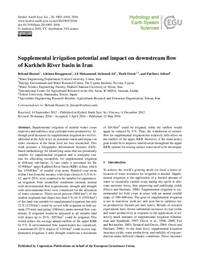Supplemental irrigation potential and impact on downstream flow of Karkheh River Basin of Iran

Authors:
Supplemental irrigation of rainfed winter crops improves and stabilizes crop yield and water productivity. Although yield increases by supplemental irrigation are well established at the field level, its potential extent and impact on water resources at the basin level are less researched. This work presents a GIS-based methodology for identifying areas that are potentially suitable for supplemental irrigation and a computer routine for allocating stream flow for supplemental irrigation in different subbasins. A case study is presented for the 42 908 km<sup>2</sup> upper Karkheh River Basin (KRB) in Iran, which has 15 840 km<sup>2</sup> of rainfed crop areas. Rainfed crop areas within 1 km from the streams, with slope classes 0–5%, 0–8%, 0–12% and 0–20%, were assumed to be suitable for supplemental irrigation. Four stream flow conditions (normal, normal with environmental flow requirements, drought and drought with environmental flow) were considered for the allocation of water resources. Thirty-seven percent (5801 km<sup>2</sup>) of the rainfed croplands had slopes less than 5%. Sixty-one percent (3559 km<sup>2</sup>) of this land was suitable for supplemental irrigation, but only 22% (1278 km<sup>2</sup>) could be served with irrigation in both fall (75 mm) and spring (100 mm), under normal flow conditions. If irrigation would be allocated to all suitable land with slopes up to 20%, 2057 km<sup>2</sup> could be irrigated. This would reduce the average annual outflow of the upper KRB by 9%. If environmental flow requirements are considered, a maximum (0–20% slopes) of 1444 km<sup>2</sup> could receive supplemental irrigation. Under drought conditions a maximum of 1013 km<sup>2</sup> could be irrigated, while the outflow would again be reduced by 9%. Thus, the withdrawal of steam flow for supplemental irrigation has relatively little effect on the outflow of the upper KRB. However, if the main policy goal would be to improve rainfed areas throughout the upper KRB, options for storing surface water need to be developed.
